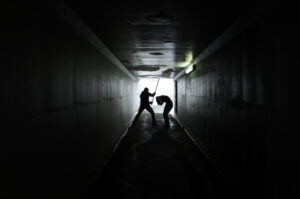Natchez was almost totally destroyed by a mile-wide tornado and 317 lives were lost.
Shortly after noon on May 7, 1840, a mile-wide tornado slammed into Natchez, Mississippi, a city on the Mississippi River, about 150 miles north of New Orleans. The storm was loaded with all kinds of debris it had picked up along its path. No one expected it and no one was warned of its approach even though the sounds of its destruction farther down the river could be heard in Natchez. Unlike the present time, there was no national weather service to alert people to an approaching storm and there were none of the things that individuals could have used to warn others, two-way radios, telephones, or cell phones. As the tornado struck Natchez, banks, homes, stores, steamboats, and other vessels were completely destroyed. Houses burst open. Three hundred and seventeen lost their lives. It was the second most deadly tornado in U.S. history.
About an hour before it struck Natchez, a thunderstorm with driving rain had formed in an area about twenty miles to the south and moments later a tornado began to form out of that same storm. The tornado gathered strength as it moved northward along the Mississippi valley. The United States gets about 1,000 significant tornadoes every year, more than the total number experienced by all other countries combined. Only one in every hundred is as powerful as Natchez. At the present time, in sharp contrast to 1840, few are killers. We now have the ability to identify the kind of weather that is likely to lead to a tornado and we can trace the paths of these twisters so that those in their paths can take shelter. Fore casting, detection, communications, and raised public awareness of the danger, all help to minimize the number of fatalities. The U.S. Weather Service in 1840 was only able to report on what was visible and measurable locally in terms of wind speed, temperature, and humidity. There was no system of communication that could relay these data quickly enough to provide a warning to those who were in the tornado’s path.
As the tornado tracked northeast, heading for Natchez, people took advantage of the cooling rain to sit out in their porches, or to walk about even in the rain because the rain provided a cooler atmosphere than the usual hot dry conditions. Many were preparing to eat, fully aware of the dangers that any thunderstorm would present but unaware that this particular storm was much more than a thunderstorm. At the very moment that the tornado struck, the dinner bells in large hotels had rung and most citizens were sitting at their tables. It is difficult for us today to appreciate the scene in Natchez in the year 1840. This was pre-Civil War America and there were two social classes of humanity living and working in the plantations and in the home—ordinary Americans and slaves. There is no reference to the deaths of slaves in the various newspapers apart from one sentence in one paper, saying that hundreds of slaves died. They died in their homes or at work in the plantations. It is quite clear from the details of life on the river, and the large number of deaths that occurred there, that the vast majority of the 317 deaths occurred among the merchants who were transporting goods on their flatboats. The hundreds of slaves who died were considered property losses.
The approaching tornado raced up the river from a point seven miles south of Natchez. As it traveled it stripped the forest from both sides of the river. Those on the river were the first to hear what must have been a thunderous roar from the river as it churned with massive waves and whitecaps. Up and down the river on either side of Natchez scores of vessels, steamboats, flatboats, and skiffs, were crowded together in great numbers, including many itinerant boatmen who traded everything from furs to liquor. Flatboats and people were tossed into the air like toys and, as they came down, they were drowned. The volume of debris as well as the tumultuous state of the water made it impossible for anyone to be rescued. One or two survived because they were thrown on to the land. As the tornado swept northwards, the central and northern parts of the town were demolished. Survivors described the air as being black, filled with spinning pieces of walls, roofs, and chimneys and with large timbers flying through the air as if shot by a catapult. Beneath the ruins lay the crushed bodies of many strangers. There were many escapes and many heartrending scenes. A woman named Mrs. Alexander was rescued from the ruins of the Steam Boat Hotel. She was seriously injured and was holding on to two dead children.
The destruction of the flat boats was an immense blow to the economy of the area. At least sixty of them were lost. It was impossible to calculate the total value of the boats and their contents. The steamboat Hinds, with most of her crew, went to the bottom, and the Prairie from St. Louis was so much wrecked as to be unfit for use. The steamer St. Lawrence, at the upper cotton press, was a total wreck. It was difficult to tell how widespread the ruin had been. Reports of major damage came in from plantations twenty miles away in the state of Louisiana. Looking back from today’s vantage point, these losses were all the more unfortunate because there were none of the aids with which we are now familiar: Red Cross, National Guard, presidential disaster decree, and mobilization of doctors and emergency personnel from other places. The townsfolk did the best they could and, as always in these earlier days, the unexpected was attributed to the deliberate action of God. One newspaper described the whole scene as the voice of the Almighty and hence prudence should dictate reverence rather than execration. Total costs of the disaster were estimated at 1.3 million dollars at the 1840 value of money.























2 thoughts on “Natchez Tornado – Mississippi – May 7, 1840”
Does anyone know how many slaves died from the tornado? They should of been
added in the death count. Perhaps if more than 400 slaves could have died. The total death count would have been great enough to come close to tying or even surpass,
the Tri-state tornado of 1925. Which had a total of 695, that perished. I believe, we may never really know.
What were the wind speeds